Prowess is a "Three-Legged Stool"
By
John Clements
ARMA Director
"He who wants to have honor in arms should have
knowledge, fortitude and courage."
- Master Filippo Vadi, c. 1482
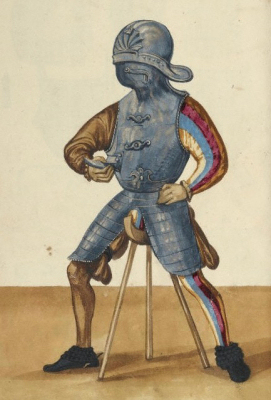 After
decades of personal study, I love being able to cultivate interest in
historical arms and armor among younger generations. Encouraging this
among youths has become a major focus of my work. Some of the most interesting
questions I'm asked about historical fencing and weaponry come from youths
who very often will pose the most direct yet challenging inquiries to
answer. For example, they might ask: why are there so many swords, or
why did swords change so much over time, how were swords made, or what
is the better sword? These are basic questions with complex answers. I
enjoy these kinds of questions because they challenge me to not only express
things succinctly, but also to examine just what it is we know about this
subject and how we came to know it. After
decades of personal study, I love being able to cultivate interest in
historical arms and armor among younger generations. Encouraging this
among youths has become a major focus of my work. Some of the most interesting
questions I'm asked about historical fencing and weaponry come from youths
who very often will pose the most direct yet challenging inquiries to
answer. For example, they might ask: why are there so many swords, or
why did swords change so much over time, how were swords made, or what
is the better sword? These are basic questions with complex answers. I
enjoy these kinds of questions because they challenge me to not only express
things succinctly, but also to examine just what it is we know about this
subject and how we came to know it.
Recently, a school-age child inquired with me as to "what was the
most important thing in studying swordsmanship?" My thoughts ran
immediately to the varied statements by Renaissance Masters of Defence
listing the many qualities and attributes necessary for a good fighter,
or their descriptions of the critical characteristics of a good swordsman.*
Their quotes on the topic are insightful and offer us practical advice,
to be sure. But their wisdom is not ideal for a short answer.
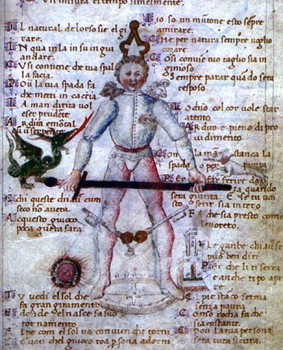 In
considering the question the child posed, I was reminded of the scene
in John Boorman's superb film, Excalibur, in which King Arthur
confronts Merlin to answer the question of what trait is the most important
in a knight. Caught off guard, Merlin tries to say that there are several,
so that it's similar to the metals blended to make a good sword blade.
Forced to provide a direct response, though, Merlin ends up replying with
one he views as standing above all. In
considering the question the child posed, I was reminded of the scene
in John Boorman's superb film, Excalibur, in which King Arthur
confronts Merlin to answer the question of what trait is the most important
in a knight. Caught off guard, Merlin tries to say that there are several,
so that it's similar to the metals blended to make a good sword blade.
Forced to provide a direct response, though, Merlin ends up replying with
one he views as standing above all.
In my attempt to avoid too scholarly a reply to the youth's question,
my answer was far less dramatic than Merlin's, but I think I still managed
to encapsulate the teachings of the historical fight-books while giving
context to the modern study of historical swordsmanship -the context being
that it was something needed to protect oneself from serious violence.
Swordsmanship was a central part of Renaissance martial arts teachings.
It represents a larger portion of the thoughts and theories on self-defence
from the period than any other topic. Its study and culture directly addressed
the fundamental ideas and concepts of close combat more so than any other
weapon or martial teachings from the time. In any martial discipline there
are undeniably several equally important elements combined, but, if anything,
their synergy is even more important in the science and art of fencing.
My view is that the thoughts of the Renaissance Masters of Defence can
be summarized as recognizing that the craft involves three key components.
Think of them as each being one leg of a sturdy "three legged stool."
Take away any one leg and the stool collapses. With all three legs in
proportion the stool supports the weight placed upon it.
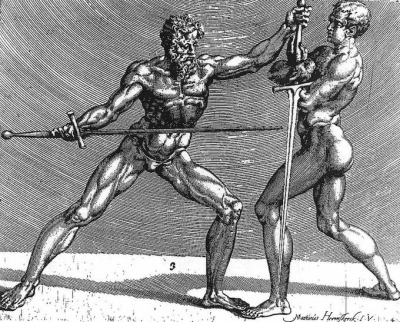 The
first "leg" of this stool is the Art itself: the idea
of having an actual fighting method. You need to have some proven
systematic combat teachings based upon sound principles of self-defence.
Repeated examples can be found in Renaissance martial arts literature
of masters cautioning against ignorance that there somehow isn't
an actual "art" of fighting. They warn of those skeptical of
its value over the natural advantage of physique alone or just the practical
know-how that comes from experience. That is to say, fighting is a subject
that can be studied, understood, and improved upon just as any other discipline. The
first "leg" of this stool is the Art itself: the idea
of having an actual fighting method. You need to have some proven
systematic combat teachings based upon sound principles of self-defence.
Repeated examples can be found in Renaissance martial arts literature
of masters cautioning against ignorance that there somehow isn't
an actual "art" of fighting. They warn of those skeptical of
its value over the natural advantage of physique alone or just the practical
know-how that comes from experience. That is to say, fighting is a subject
that can be studied, understood, and improved upon just as any other discipline.
Yet, the whole point of the Art is to overcome naturally stronger opponents
-or at least to give you a chance against those who have inherent physical
advantages. The mid-15th century fight-book teachings of the Codex
Wallerstein tell us specifically that in serious combat a weak fighter
can be equal to a strong opponent "…if he has previously learned."
That is, if he has skill. Essentially, this means having a codified
doctrine that essentially instructs in the applied knowledge of timing,
distance, leverage, and technique -a science of defence, as it
was known. Despite differences between fighters and methods, as the Master
Joachim Meyer expressed in 1570, everything still relies upon a common
knowable foundation. But just having a fighting method is not enough.
One must acquire proficiency in its earnest application.
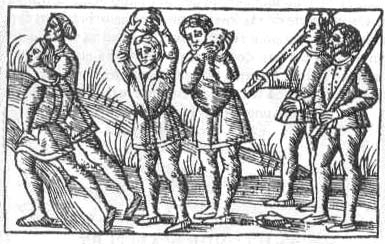 This
brings us to the second "leg" of the stool -conditioning.
That is, you must be exercised in the physical performance of a
fighting method and accomplished in its motions. This means you need to
have the requisite physicality to develop the ability to move with essential
coordination and act with necessary force. Being aware of theories and
teachings doesn't do you any good if you can't effectively use them for
lack of training. One must actually practice. Techniques are ineffective
if you lack the speed and power that only comes through experience moving
with control. This
brings us to the second "leg" of the stool -conditioning.
That is, you must be exercised in the physical performance of a
fighting method and accomplished in its motions. This means you need to
have the requisite physicality to develop the ability to move with essential
coordination and act with necessary force. Being aware of theories and
teachings doesn't do you any good if you can't effectively use them for
lack of training. One must actually practice. Techniques are ineffective
if you lack the speed and power that only comes through experience moving
with control.
Master Liechtenauer is chronicled in 1389 as teaching that "exercises
are better than art, as exercises help without the art, but the art is
of no help without exercises." This is true. Merely studying so that
you "know all about it" without being competent in adversarially
employing it is useless for achieving real skill. This comes only through
devoted physical effort. The Art isn't more important than conditioning.
Why? Because, generally, someone of physical dominance with a little bit
of training yet a good martial attitude is going to overcome someone of
more training but lesser physique and weaker mindset. And yet, master
Liechtenauer also rightly tells us that the whole purpose of the Art is
to overcome an opponent who is stronger than you. He even asks that if
this were not so what then would be the purpose of the Art? As the master
Filippo Vadi expressed it in 1482, "cunning defeats any strength."
In other words, skillfulness and training overcome natural brutality.
Just possessing theoretical knowledge is not enough, though. You still
have to have to have capacity in applying it, and the degree required
for this can vary between disciplines or methods. Even then, athleticism
and endurance only carry you so far in fighting. It doesn't matter if
you are tough and fit if you lack any real craft of fighting to best harness
it.
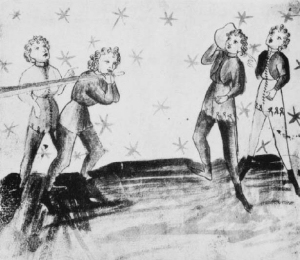 Similarly,
along with practical know-how and ability, one must also have the right
mindset or will. This then is the third leg of the stool: attitude.
Just as one hones technical skill and physical ability, one must develop
a certain Kampfgeist ("martial spirit"). The psychological
component -the mental/emotional (even spiritual and ethical) outlook-
is no less critical. Similarly,
along with practical know-how and ability, one must also have the right
mindset or will. This then is the third leg of the stool: attitude.
Just as one hones technical skill and physical ability, one must develop
a certain Kampfgeist ("martial spirit"). The psychological
component -the mental/emotional (even spiritual and ethical) outlook-
is no less critical.
History is filled with examples attesting to the importance of mindset
and fighting morale for the warrior. The ideal mental state is to neither
fight in fear nor out of anger. It's easy to imagine a determined combatant
declaring, "Nothing's gonna stop me!" or "I'll crush you"
or even exclaiming in panic, "I don't know what to do!?" Dealing
with such emotions is part of what a fighting discipline is all about.
You must keep your head in the game, stay focused, not be distracted and
"out of it" or otherwise distraught in some debilitating way.
Otherwise, all your training and conditioning will fail no matter the
sophistication of your skill set. To act resolutely and boldly when faced
with violence and be free of doubt and anxiety as you do, is really (in
the chivalric sense) to display valor.
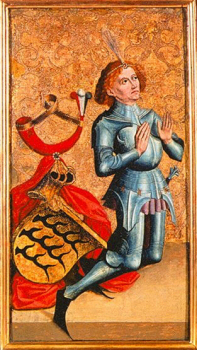 Still,
one cannot rely only on being determined and courageous. Acting indomitably
in the face of adversity and violent conflict is certainly valuable, but
on its own it simply can't compensate for lack of wisdom and deficiency
of ability. It won't get you very far when you're not sufficiently trained
in a sound martial discipline -the other two legs. All of this is still
tied together with a proper fighting mindset or, as Master Fiore dei Liberi
expressed it in 1410, audacity… such is what the Art is all about.
Fiore stressed that the mind should be free from fear, and only in this
condition can you develop your capacities and improve yourself. This is
a proven and trustworthy sentiment in the study of "combatives."
The historical writings spend a great deal of time addressing this psychological
component.* Still,
one cannot rely only on being determined and courageous. Acting indomitably
in the face of adversity and violent conflict is certainly valuable, but
on its own it simply can't compensate for lack of wisdom and deficiency
of ability. It won't get you very far when you're not sufficiently trained
in a sound martial discipline -the other two legs. All of this is still
tied together with a proper fighting mindset or, as Master Fiore dei Liberi
expressed it in 1410, audacity… such is what the Art is all about.
Fiore stressed that the mind should be free from fear, and only in this
condition can you develop your capacities and improve yourself. This is
a proven and trustworthy sentiment in the study of "combatives."
The historical writings spend a great deal of time addressing this psychological
component.*
Most all the major Renaissance masters and fight-book sources list physical
elements combined with mental ones when they describe the things that
the Art itself consists of or that a practitioner requires in order to
master it. At the risk of reformulating their ideas, these lists can all
be condensed down to essentially three factors: the tactical, the physical,
and the mental. These three factors are not unlike how, in order to conduct
war, a nation state must have three critical things: strategic doctrine,
military capacity, and political will. Absent any one and they will likely
suffer 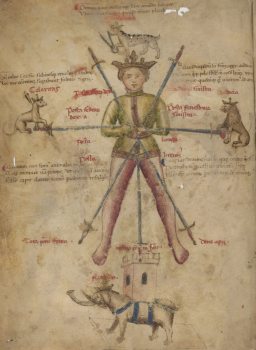 defeat
when they enter into armed conflict. One way to look at this is that even
as there are natural physical and mental dispositions at work, it is training
that provides competence to nurture our confidence as fighters. Or as
Master George Silver put it in 1599, because people "desire to find
a true defence for themselves in their fight, therefore they seek it diligently,
nature having taught us to defend ourselves and Art teaching us how." defeat
when they enter into armed conflict. One way to look at this is that even
as there are natural physical and mental dispositions at work, it is training
that provides competence to nurture our confidence as fighters. Or as
Master George Silver put it in 1599, because people "desire to find
a true defence for themselves in their fight, therefore they seek it diligently,
nature having taught us to defend ourselves and Art teaching us how."
In answering the child's question about swordsmanship's single most important
thing, my reply was that there isn't one. There are three. I don't see
how we could say any one takes precedent over the other two. They each
require one another. They are a trinity, inseparable and interconnected,
synergistic and interdependent. The best word I have come across to use
for describing what these three "legs" represent is preudhome
or knightly prowess: know-how and skill matched to a focused will. It's
all about applying the central underlying principia of self-defense,
but it recognizes that acquiring a knowledge base of fighting actions
is ultimately both a mental and physical process. Preudhome incorporates
all three aspects. Martial ability is knowledge of the core tenets and
principles, while conditioning is the physicality of exercise and training
in techniques, and attitude is the psychologic (i.e.,the mental
outlook and emotional state). All of this -knowledge, conditioning,
attitude- constitutes skill in personal close-combat. It really is
akin to the three legs of a stool; if missing any one it will collapse.
This gives even greater weight to the cautionary words of Master Filippo
Vadi from his treatise on fighting in c.1482: "He who wants to have
honor in arms should have knowledge, fortitude and courage, if these he
lacks, he'd better renounce [study]" In other words, mastering your
martial art means having all three legs: knowledge, conditioning,
and attitude -the very "stool of defence."
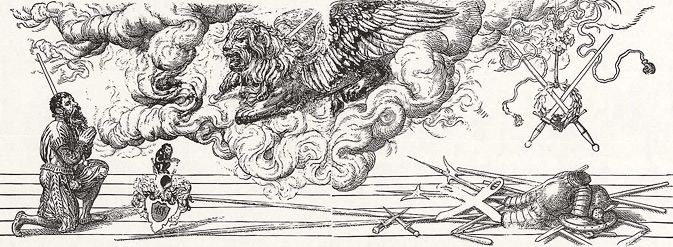
**Despite decades of pop-culture commercialism and hyperbole
to the contrary, learning martial arts is actually pretty easy. Ultimately,
it comes down to acquiring basic core tenets that teach fundamental principles
universal to all personal self-defense. It's really a matter of having
in place a working doctrine of proven concepts matched to a sufficient
repertoire of learned techniques -what we might term, practicum et
principia. In a sense, when learning a martial art every student will
have certain questions about what techniques and concepts they are shown.
For example: "What was that?" "How do I do that?"
"When should I use that?" "How do I practice that?"
"Am I doing that correctly?" These are fundamental issues
that occur continually. But the ultimate question for a martial artist
may be, "What happens if I have to use that for real?"
In other words, what results physically and psychologically to the fighter
from using their violent skills in earnest emergency? The Renaissance
Masters of Defence were far from silent in addressing the topic.
|

